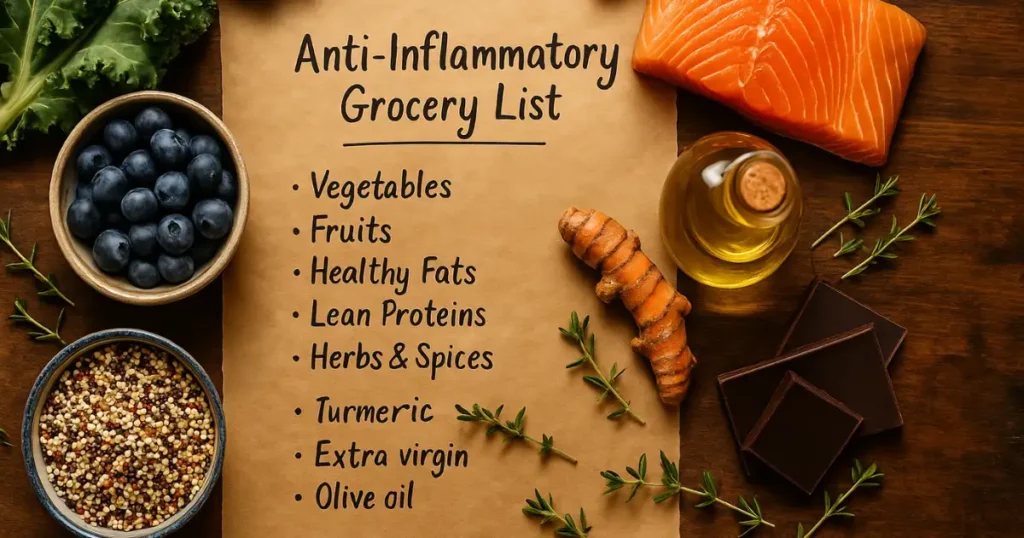This anti-inflammatory grocery list is your starting point if you’re feeling puffy, achy, and tired without answers. For years, I woke up feeling like I had walked uphill in my sleep. My joints ached, my brain felt foggy, and no amount of coffee brought real energy. Doctors ran tests. Everything looked “fine.” But I didn’t feel fine. It wasn’t until I discovered the connection between chronic inflammation and food that things finally began to shift.
Inflammation isn’t just about visible swelling or pain. It’s a hidden fire that affects everything from your mood to your metabolism. While acute inflammation is your body’s natural healing response, chronic inflammation simmers quietly behind many common conditions like fatigue, migraines, joint pain, and even mood swings.
Here’s the good news. The foods you eat hold powerful tools for calming that fire. The anti-inflammatory diet is not a fad. It’s a return to real, colorful, nourishing food that helps your body repair itself. And it starts with something as simple as your next grocery trip.
In this guide, I’ll walk you through the exact foods I recommend to my clients, friends, and family when they’re ready to start healing. You’ll learn:
- Which foods help fight inflammation from the inside out
- What ingredients may be secretly fueling aches and brain fog
- Simple shopping tips that make eating this way doable, even on a budget
- And yes, a printable grocery list to take straight to the store
Let’s simplify healing together, one cart at a time.
Key Takeaways
- An anti-inflammatory diet can help reduce joint pain, brain fog, and fatigue.
- Focus on whole foods, such as vegetables, fruits, healthy fats, lean proteins, and herbs.
- Avoid added sugars, refined carbs, processed meats, and highly processed oils.
Ready to dig in? Let’s talk about what inflammation really is and why it matters.
What is Inflammation?
Inflammation is your body’s natural defense system. When you scrape your knee or catch a cold, your immune system kicks into gear to repair damage and fight invaders. That’s acute inflammation, and it’s a good thing. It helps you heal.
But when inflammation lingers long after the threat is gone, that’s when trouble starts. Chronic inflammation works in the background, slowly wearing down tissues, joints, and organs. It’s like a faucet left dripping for months. You may not notice right away, but eventually, it leaves damage behind.
Common triggers of chronic inflammation include poor diet, chronic stress, lack of sleep, environmental toxins, and even food sensitivities. Over time, these stressors confuse the immune system and keep it in a constant state of alert.
Who Can Benefit from an Anti-Inflammatory Diet?
This way of eating supports healing for just about everyone, but it’s especially helpful for people living with:
Obesity and Metabolic Syndrome
Excess body fat, especially around the belly, produces inflammatory chemicals. The anti-inflammatory diet helps stabilize blood sugar and reduce this strain.
Type 2 Diabetes
Inflammation plays a key role in insulin resistance. Whole foods rich in fiber and antioxidants can help improve blood sugar control.
Heart Disease
Chronic inflammation contributes to artery damage. Anti-inflammatory fats like omega-3s support heart health and reduce risk.
Autoimmune Conditions (like Rheumatoid Arthritis or Lupus)
These conditions involve an overactive immune system. Calming foods help reduce flare-ups and joint pain.
Digestive Issues (like IBS or Bloating)
Certain foods soothe the gut lining and support a healthier microbiome, easing symptoms over time.
Cognitive Health and Mood
Brain fog, anxiety, and low mood are often linked to inflammation in the brain. Nutrient-rich foods with antioxidants and healthy fats feed both body and mind.
Chronic Pain and Fatigue
Reducing inflammation helps ease muscle soreness and boost consistent energy.
If you’ve felt like your body is out of sync, this might be your starting point. You don’t need to overhaul your life overnight. Start with what you eat. The difference can be remarkable.
Building Your Anti-Inflammatory Plate
Let’s simplify healing by starting with your plate. When you’re building meals to calm inflammation, think color, variety, and simplicity. Focus on whole foods that nourish your cells and calm your immune system instead of triggering it.
There are four key components I always keep in mind when meal planning:
Antioxidants
These are your body’s natural defenses against cell damage. Found in vibrant fruits, veggies, and herbs.
Fiber
Supports digestion, balances blood sugar, and feeds your good gut bacteria.
Omega-3 Fatty Acids
Fight inflammation at the source. Found in fatty fish, flaxseeds, and walnuts.
Polyphenols and Phytonutrients
These plant-based compounds protect your cells and promote healing from within.
Now, let’s fill your shopping cart with the good stuff.
Foods to Include: Your Anti-Inflammatory Shopping Cart

Vegetables
Aim for a rainbow. Each color brings unique nutrients to the table.
- Leafy Greens like kale, spinach, and Swiss chard are rich in magnesium and vitamins that calm inflammation.
- Cruciferous Veggies such as broccoli, cauliflower, and Brussels sprouts contain sulfur compounds that help detox the body.
- Alliums including garlic, onions, and leeks are powerful anti-inflammatory warriors.
- Root Vegetables like carrots, beets, and sweet potatoes are packed with fiber and antioxidants.
- Colorful Varieties such as red cabbage and bell peppers provide a wide range of protective compounds.
Fruits
Choose fresh or frozen and aim for low to medium glycemic options.
- Berries like blueberries, strawberries, and raspberries are full of anthocyanins, which fight oxidative stress.
- Cherries contain compounds that may help ease joint pain.
- Oranges and Citrus deliver vitamin C and flavonoids.
- Apples are high in quercetin, a plant compound with anti-inflammatory effects.
Healthy Fats and Oils
Not all fats are bad. Some are essential for reducing inflammation.
- Extra Virgin Olive Oil is rich in oleocanthal, a natural anti-inflammatory.
- Avocados provide monounsaturated fats that support heart and brain health.
- Nuts and Seeds like almonds, walnuts, chia, and flax are packed with fiber and omega-3s.
Lean Proteins
Quality matters here. Choose a protein that nourishes without promoting inflammation.
- Fatty Fish such as salmon, mackerel, and sardines are loaded with omega-3s.
- Lean Poultry like chicken and turkey is a great clean protein source.
- Legumes including lentils, beans, and chickpeas offer plant-based protein and fiber.
- Tofu and Tempeh are fermented soy options that support gut health.
- Eggs from pasture-raised hens provide healthy fats and antioxidants.
Whole Grains and Complex Carbohydrates
These are your slow-burning energy sources.
- Oats are rich in beta-glucan, which helps regulate immune responses.
- Quinoa is a complete protein and a great gluten-free grain.
- Brown Rice provides minerals and fiber.
- Sweet Potatoes are rich in beta-carotene and fiber.
Herbs and Spices
These are tiny but mighty.
- Turmeric contains curcumin, known to calm inflammation naturally.
- Ginger supports digestion and eases pain.
- Cinnamon helps regulate blood sugar.
- Garlic boosts immunity and reduces inflammation.
- Oregano and Thyme offer antibacterial and anti-inflammatory benefits.
Beverages
Hydration is key for healing.
- Green Tea contains catechins, powerful plant compounds.
- Filtered Water is essential for flushing out toxins.
- Herbal Teas like peppermint, chamomile, and rooibos support calm and digestion.
Pantry Staples and Condiments
These support easy cooking without reaching for processed sauces.
- Apple Cider Vinegar supports digestion and blood sugar control.
- Fermented Foods such as sauerkraut, kimchi, and miso are gut-friendly.
- Bone Broth is rich in amino acids that soothe the gut lining.
- Dark Chocolate with at least 70 percent cacao contains antioxidants.
Foods to Avoid: Inflammatory Triggers
These are the foods that can quietly fan the flames.
- Added Sugars and High-Fructose Corn Syrup spike insulin and increase inflammation.
- Refined Carbohydrates, such as white bread, pastries, and sugary cereals, lack fiber and nutrients.
- Processed Meats, like bacon, hot dogs, and deli meats, contain preservatives and advanced glycation end-products that worsen inflammation.
- Trans Fats and Excess Saturated Fats are found in fried foods and processed snacks.
- Vegetable Oils High in Omega-6, such as corn, soybean, and sunflower oils, can throw off your omega balance.
- Excessive Alcohol irritates the gut and burdens the liver, making inflammation worse.
Stocking your kitchen with healing foods is the first real step toward feeling better. Next up, I’ll help you make this doable, even on a tight budget.
Tips for Your Anti-Inflammatory Grocery Shopping Trip
Let’s be honest. Grocery shopping can feel overwhelming, especially when you’re making changes for your health. The good news is that small tweaks make a big difference. Here are my go-to tips to make shopping simpler and smarter.
Read Labels Carefully
Look out for sneaky ingredients like added sugars, inflammatory oils, and artificial preservatives. If you don’t recognize an ingredient, chances are your body won’t either.
Shop the Perimeter of the Store
This is where the real food lives. Fresh produce, meat, fish, eggs, and dairy typically line the outer aisles. Skip the middle unless you’re grabbing pantry staples.
Buy in Season and Local
Seasonal produce is not only more affordable but also more flavorful and nutritious. Farmers’ markets are your best friend for this.
Prioritize Organic Where It Counts
You don’t need to go all-organic. Use the Environmental Working Group’s Dirty Dozen list as a guide for what to prioritize.
Stock Your Pantry Smartly
A well-stocked pantry is your best ally on busy days. Keep dry staples like lentils, brown rice, quinoa, canned beans, olive oil, herbs, and spices on hand for quick meals.
Building Your Anti-Inflammatory Grocery List on a Budget
Healthy doesn’t have to mean expensive. When I first transitioned my kitchen, I was working with a tight budget and a lot of trial and error. These are the tips I still use today.
Affordable Proteins
Beans, lentils, and eggs are some of the most budget-friendly proteins. Canned wild salmon and frozen fish fillets often cost less than fresh and keep longer.
Buy Frozen Produce
Frozen fruits and vegetables are picked at peak ripeness and retain most of their nutrients. They’re also convenient and often cheaper than fresh.
Shop Sales and Plan Ahead
Check weekly store flyers. Plan your meals around what’s on sale. If your budget allows, buy in bulk and freeze extras.
Batch Cooking Saves Time and Money
Make a big pot of soup, stew, or chili on Sunday. Freeze half for later. This makes healthy eating feel easier midweek.
DIY Sauces and Dressings
Skip the bottled versions that often contain added sugars and low-quality oils. Blend olive oil, vinegar, garlic, and herbs for an easy dressing. Keep it simple.
Sample Anti-Inflammatory Meal Plan
Here’s a peek at what three days of anti-inflammatory eating might look like. Each meal is built around real, satisfying ingredients that support healing.
Day 1
Breakfast: Steel-cut oats with chia seeds, blueberries, and cinnamon
Lunch: Quinoa salad with chickpeas, arugula, cucumbers, and tahini dressing
Dinner: Baked salmon with roasted Brussels sprouts and sweet potato wedges
Day 2
Breakfast: Green smoothie with spinach, avocado, banana, flaxseeds, and almond milk
Lunch: Lentil soup with a side of mixed greens and olive oil
Dinner: Turkey stir-fry with broccoli, bell peppers, and brown rice
Day 3
Breakfast: Scrambled eggs with turmeric, garlic, and sautéed kale
Lunch: Hummus wrap with roasted vegetables and a side of apple slices
Dinner: Grilled tempeh with quinoa and steamed carrots
If you’re ready to take this further, I always recommend starting with a small batch of meals you know you’ll enjoy. Healing should feel doable, not rigid. Keep it nourishing, not perfect.
Your Anti-Inflammatory Questions Answered
Starting an anti-inflammatory lifestyle often brings up a few big questions. Let’s walk through the ones I hear most often from my clients and readers.
How long does it take for an anti-inflammatory diet to work?
Everyone’s body is different, but most people begin to notice subtle changes within the first two to three weeks. You might experience better digestion, more energy, fewer headaches, or clearer skin. Deeper shifts like reduced joint pain or stabilized mood can take a bit longer, often four to eight weeks. Healing is a process, and food is a gentle but powerful tool.
Can I cheat on an anti-inflammatory diet?
Life isn’t perfect, and neither is eating. One slice of cake or a night out won’t undo your progress. What matters is the pattern over time. I encourage a flexible, forgiving approach. If you stray from your usual choices, just return to your next nourishing meal. Guilt has no place at the table.
Will nightshades worsen my symptoms?
Nightshades like tomatoes, peppers, eggplant, and white potatoes often get blamed for triggering inflammation, especially in people with autoimmune conditions. The truth is, most people tolerate them well. They contain powerful antioxidants like lycopene and vitamin C. However, if you notice flare-ups after eating them, consider a short elimination to see how your body responds. Always listen to your symptoms over trends.
Do I need to go one hundred percent anti-inflammatory?
Not at all. The goal isn’t perfection. It’s about choosing more healing foods most of the time. That shift alone can quiet inflammation and help your body reset. Think of it as crowding your plate with good stuff so there’s less room for the not-so-good.
What supplements are recommended for inflammation?
Whole food always comes first. That said, some people benefit from adding omega-3 fish oil, turmeric capsules, or magnesium. I recommend speaking with a healthcare provider before starting supplements, especially if you have a health condition or take medications.
Types of Anti-Inflammatory Diets
Several popular diets naturally support inflammation reduction. Here’s how they compare and why they work.
Mediterranean Diet
Rich in olive oil, fish, whole grains, vegetables, and legumes. Backed by science for heart health, brain support, and reduced inflammation.
DASH Diet
Originally designed to lower blood pressure, this plan emphasizes fruits, vegetables, whole grains, and low-fat dairy. It limits sodium and processed foods, which also helps reduce inflammation.
MIND Diet
A blend of the Mediterranean and DASH diets, created to support brain health. It focuses on leafy greens, berries, nuts, and fish while limiting sugar and fried foods.
Each of these styles shares a common core: real, whole foods that nourish instead of inflame. You don’t have to follow any one diet strictly. Take what works for you and build a lifestyle you can enjoy.
Conclusion
If you’ve made it this far, take a deep breath and give yourself credit. Just by reading, you’ve already taken the first step toward healing.
An anti-inflammatory diet isn’t about strict rules or cutting out joy. It’s about filling your plate with food that helps your body feel safe, nourished, and supported. It’s about choosing meals that give you energy instead of draining it. Whether you’re dealing with daily aches, chronic fatigue, or want to feel more vibrant, the way you eat can change everything.
Start small. Add color to your meals. Choose ingredients with purpose. With each grocery trip, you’re building something better for yourself.
Healing doesn’t happen overnight. But each choice adds up. And before you know it, your body begins to respond with less pain, more clarity, and a new sense of ease.
If you’re ready for deeper guidance, consider working with a certified nutrition professional. Personalized advice can make all the difference.
Your body knows how to heal. Let’s just support it.
With warmth and wellness,
Elena 💚
Scientific References
The information in this guide is rooted in current research and best practices in holistic nutrition. Below are several trusted sources used to support the dietary recommendations and health claims discussed:
- Harvard T.H. Chan School of Public Health: The Nutrition Source
- National Institutes of Health: Office of Dietary Supplements
- Arthritis Foundation: Anti-Inflammatory Foods for Arthritis
- Mayo Clinic: Anti-Inflammatory Diet Basics
- Journal of the American College of Nutrition
- Advances in Nutrition Journal
- British Journal of Nutrition
- Nutrients (peer-reviewed open-access journal)
These resources offer deeper insights if you’re interested in the science behind your food choices.



